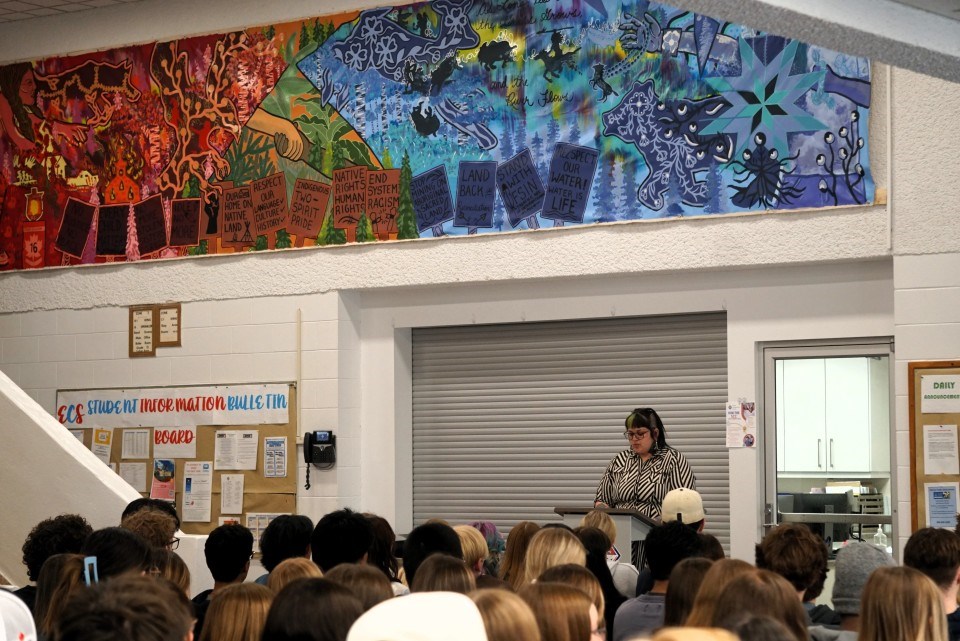ESTEVAN – The Estevan Comprehensive School (ECS) officially welcomed Cree-Métis artist Geanna Dunbar back to Estevan on April 8-9, as a powerful mural she created during a previous residency was unveiled as a permanent fixture in the school’s front foyer.
The large-scale canvas, titled Reconcil-onialism, was painted by Dunbar in just five days during a mini-residency at the Estevan Art Gallery and Museum. The mural was donated by Dunbar to the gallery's permanent collection, and now – thanks to the generosity of the gallery and its curator – it will live on at ECS, where it continues to spark conversation and reflection.
“I intended for the name itself to be challenging to pronounce,” said Dunbar. “Just as the work and the history it embodies are difficult pills to swallow.”
The mural reflects Dunbar’s deeply personal journey and commitment to reconciliation through art. It tackles themes of Indigenous identity, historical injustice and hope for the future.
“Reconcil-onialism is a work that echoes pieces from Altar-native. Where Altar-native shows the past and present, Reconcil-onialism illustrates the present and the future,” she said.
Standing before groups of ECS students and staff, Dunbar offered insight into the symbolism woven throughout the painting.
“The red in the mural pulses with the fierce spirit of Indigenous resilience in the struggle, while the warm oranges whisper the collective heartbreak experienced by Indigenous communities,” she said. “Shades of blue sweep across the canvas, representing both the tears of the lost and the hope of healing and reconciliation.”
Throughout the piece, viewers will notice animals and patterns – each carefully chosen, she noted.
“The two patterns in the animals are the different roads, like the eagle and the wolf,” Dunbar explained. “I wanted to focus also more on the future and what it can look like and the symbolism, what would that be like.”
She also spoke about the feminine and masculine elements of the mural and the broader implications they hold in Indigenous communities.
“I definitely wanted to have the feminine, the masculine side,” she said. “I see a lot of the women healing… our men have to do more work, and we have to work together in harmony to really make reconciliation and resurgence and reclamation happen.”
ECS Principal James Jones said the mural was a natural fit for the school and a vital step toward truth and reconciliation.
“After standing in front of this mural with our students and seeing how students … were brought to silence, then they were intrigued, they had questions, and it generated great conversation, I knew it was something that I was interested in having on display here and I knew that it was a powerful canvas that would generate important conversations about truth and reconciliation,” Jones said.

The С����Ƶ began with a land acknowledgement led by SRC co-presidents Prysm Gooding and Blake Hlohovsky Andrist, who also shared their connections to the history С����Ƶ honoured.
“As someone who benefits from treaties, I can see how important it is to respect and care for the land that has been shared with us,” said Hlohovsky Andrist. “We at ECS respect and honour the treaties that were made on all territories.”
Gooding reflected on her Métis identity and what truth and reconciliation means to her.
“I believe that we all have a part in reconciliation,” Gooding said. “No matter who you are or where you are from, we should treat each other with dignity and love.”
During her visit, Dunbar also led a traditional smudging С����Ƶ and explained the spiritual importance of Indigenous medicines like tobacco, sage, sweetgrass and cedar.
“Tobacco is considered a sacred plant and is often used as an offering in prayer and С����Ƶ,” she said. “It acts as a medium to communicate with the Creator in the spirit world.
“As we share this mural today, we launch an invitation, a call to action, for empathy, awareness and ultimately change,” said Dunbar. “Together may we continue to push for justice and amplify voices that have long been silenced.”




